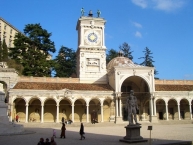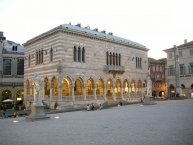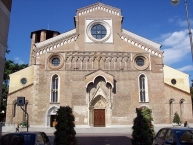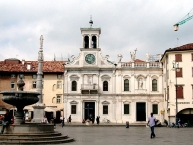Udine
Worth visiting
Added on 05 Oct 2014,
last edited by biroto-Redaktion on 05 May 2022
Nearby cycle routes and tours
| Route name | Type | Dist. to route |
|---|---|---|
Route | 0,0 km | |
Route | 0,0 km | |
Route | 0,2 km | |
Tour | 0,0 km | |
Tour | 0,0 km | |
Tour | 0,0 km | |
Tour | 0,0 km | |
Tour | 0,0 km | |
Tour | 0,0 km | |
Tour | 0,1 km |
![]()
Please wait - map data are loading
Type of sights
Old town
Name and address
Udine
IT-33100 Udine
GEO-data
Geodetic coordinates
46.06∎∎∎∎ 13.23∎∎∎∎
Elevation
113 m
Communication
Information about copyright | |
|---|---|
Rights owner | |
Rights characteristic / license | by-sa: CREATIVE COMMONS Attribution-ShareAlike |
Link to the description of the license | |
Image taken over from | |
Image has been uploaded | by biroto-Redaktion on 05 Oct 2014
|
Information about copyright | |
|---|---|
Rights owner | |
Rights characteristic / license | by-sa: CREATIVE COMMONS Attribution-ShareAlike |
Link to the description of the license | |
Image taken over from | commons.wikimedia.org/wiki/File:Udine,_loggia_di_lionello_04.JPG |
Image has been uploaded | by biroto-Redaktion on 05 Oct 2014
|
Information about copyright | |
|---|---|
Rights owner | |
Rights characteristic / license | cc0: Public Domain no Rights reserved |
Link to the description of the license | |
Image taken over from | |
Image has been uploaded | by biroto-Redaktion on 05 Oct 2014
|
Information about copyright | |
|---|---|
Rights owner | |
Rights characteristic / license | by-sa: CREATIVE COMMONS Attribution-ShareAlike |
Link to the description of the license | |
Image taken over from | |
Image has been uploaded | by biroto-Redaktion on 05 Oct 2014
|
Udine (Friulian: Udin, Slovene: Videm, German: Weiden, Latin: Utinum) is a city and comune in northeastern Italy, in the middle of the Friuli-Venezia Giulia region.
Udine is the historical capital of Friuli. The area has been inhabited since the Neolithic age, and was later, most likely, settled by Illyrians.
After the fall of the Western Roman Empire, the area increased in importance after the decline of Aquileia and afterwards of Cividale also. In 983 AD Udine was mentioned for the first time, with the donation of the Utinum castle by emperor Otto II to the Patriarchs of Aquileia, then the main feudal lords of the region. In 1223, with the foundation of the market, the city became finally the most important in the area for economy and trades, and also became the Patriarch's seat.
In 1420, it was conquered by the Republic of Venice. In 1511, it was the seat of a short civil war, which was followed by an earthquake and a plague. Udine remained under Venetian control until 1797, being the second largest city in the state. After the short French domination which ensued, it was part of the Austrian-puppet Lombardy-Venetia Kingdom, and was included in the newly formed Kingdom of Italy in 1866.
During World War I, before the defeat in the battle of Caporetto, Udine became the seat of the Italian High Command and was nicknamed "Capitale della Guerra" ("War Capital"). After the battle, it was occupied by Austrians in 1918 until after the Battle of Vittorio Veneto in 1918. After the war it was made capital of a short-lived province (Provincia del Friuli) which included the current provinces of Gorizia, Pordenone and Udine. After 8 September 1943, when Italy surrendered to the Allies in World War II, the city was under direct German administration, which ceased in April 1945.
Main sights
The old residence of the patriarchs of Aquileia, the palazzo Patriarcale, was erected by Giovanni Fontana in 1517 in place of the older one destroyed by an earthquake in 1511. Under the Austrians it was used as a prison.
In the 1550s, Andrea Palladio erected some buildings in Udine. The church of Santa Maria della Purità has 18th-century frescoes by Giambattista Tiepolo and his son Domenico.
The church dedicated to St. Mary of the Castle is probably the oldest in Udine, judging from extant fragments dating back to the Lombard era. It lost its parish status in 1263, when it was annexed to the larger parish of Saint'Odorico (now the Cathedral). It has been renovated many times over the centuries: the façade, for example, was entirely rebuilt after the catastrophic earthquake of 1511. Its three naves preserve the suggestive atmosphere of silence and contemplation, which is often found in old churches. The Venetian Governor, Tommaso Lippomano, commissioned the Venetian Gothic portico with steps and ramps leading down the hill in 1487.
In the principal square (Piazza della Libertà) stands the town hall (Loggia del Lionello) built in 1448–1457 in the Venetian-Gothic style opposite a clock tower (Torre dell’Orologio) resembling that of the Piazza San Marco at Venice. It was begun in 1448 on a project by Nicolò Lionello, a local goldsmith, and was rebuilt following a fire in 1876. The new design was projected by the architect Andrea Scala.
Opposite the Loggia del Lionello is the Loggia di San Giovanni, a Renaissance structure designed by Bernardino da Morcote. Other noteworthy monuments in the square are the Fountain by Giovanni Carrara, an architect from Bergamo (1542); the Columns bearing the Venetian Lion and the Statue of Justice (1614), the statues of Hercules and Cacus and the Statue of Peace (1819) which was donated to Udine by Emperor Francis I to commemorate the peace Treaty of Campoformido.
The Cathedral of Udine is an imposing edifice whose construction started in 1236, on a Latin cross-shaped plan with three naves and chapels along the sides. The church was consecrated in 1335 as Santa Maria Maggiore. At the beginning of the 18th century a radical transformation project involving both the exterior and the interior was undertaken at the request and expense of the Manin family. The Baroque interior has monumental dimensions and contains many works of art by Tiepolo, Amalteo, and Ludovico Dorigny. On the ground floor of the bell tower (built from 1441 over the ancient baptistry) is a chapel which is completely adorned with frescoes by Vitale da Bologna (1349).
The center of Udine is dominated by the Castle , built by the Venetians from 1517 over a Lombard fortification ruined by an earthquake in 1511. The current Renaissance appearance dates from the intervention of Giovanni da Udine, who finished the works starting from 1547. The castle houses one of the most ancient Parliament Halls of Europe.
Information about copyright | |
|---|---|
Rights characteristic / license | by-sa: CREATIVE COMMONS Attribution-ShareAlike |
Link to the description of the license | |
Input taken over from: |
Wikipedia contributors, 'Udine', Wikipedia, The Free Encyclopedia, 21 September 2014, 16:01 UTC, http://en.wikipedia.org/w/index.php?title=Udine&oldid=626491243 |
taken over / edited on | 05 Oct 2014 - 05 May 2022
|
taken over / edited by |
|
Nearby cycle routes and tours
| Route name | Type | Dist. to route |
|---|---|---|
Route | 0,0 km | |
Route | 0,0 km | |
Route | 0,2 km | |
Tour | 0,0 km | |
Tour | 0,0 km | |
Tour | 0,0 km | |
Tour | 0,0 km | |
Tour | 0,0 km | |
Tour | 0,0 km | |
Tour | 0,1 km |
Added on 05 Oct 2014,
last edited by biroto-Redaktion on 05 May 2022




